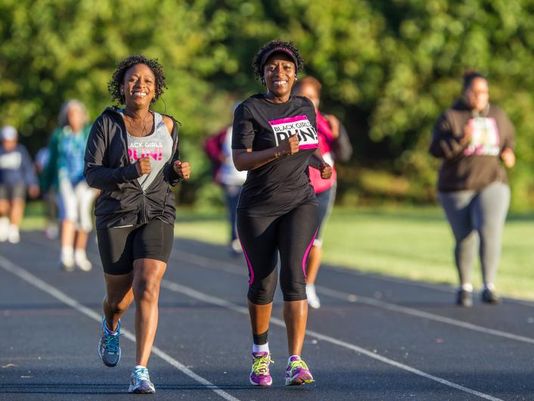Driving with me is fun. If I’m in my car and see a runner, this is what happens: I check out their kit. I check out how they’re running. A heavy heel striker? “Thump thump.” Someone who should do more core strengthening? “Look at that flailing foot.” Pretty much every woman runner I see, ever? “GET A BETTER SPORTS BRA.”
Women, what’s up with you? You’ll spend a fortune on luxury printed leggings, but you let your breasts bounce all over the place because you’re wearing a cheap low-impact high-street bra that is doing nothing for your breasts or your health. A sign at the London Marathon said it clearly enough: “You may run a 26.2 or so miles at a marathon, but your breasts will have moved three miles further.” Yes, even us small-chested runners. Go to the Shock Absorber website and watch their “bounce-o-meter” video of how much runners’ breasts move. Even small ones. It’s shocking.
Breasts have no muscles. They are made up of fatty tissue stuck to the chest, and when you run, they move, and all that is holding them up are fibrous strands called Cooper’s ligaments. A D cup – the average size of UK women – is 1kg of weight. If the breast is bouncing around, then the ligament is getting stretched – no matter what size your breast – leading to breast droop (a lovely phrase) and discomfort or pain.
Not only do even small breasts bounce around, but they are moving three-dimensionally: up, down and sideways. It is immense impact. Shock Absorber research has found that 44% of women who exercise regularly don’t wear sports bras. And even small breasts move 40mm away from the body. The farthest an unsupported breast can travel is 14cm. Their data comes from research led by Dr Joanna Scurr of the University of Portsmouth, which has a breast health team in its sports science faculty, and which has also discovered that 70% of women wear the wrong-sized bra. (That includes me: 35 years a 34A, or so I thought, until a specialist bra fitter put me in a 30C – it felt perfect.)
A good sports bra will limit excessive movement using various tricks and technologies, so that the impact on the ligament is contained, and your breast tissues are better protected from damage. Yet some high-street retailers don’t even provide high-impact bras for lower than a C-size cup. I noticed this when I was looking for a sports bra in Tesco’s F&F range, but Tesco isn’t the only retailer that thinks a small cup size must mean we have suddenly sprouted magic breast-holding muscles. Wrong.
Sports clothing company Brooks recently launched a Moving Comfort range. It sent me a Fiona bra to try out (disclaimer: I like it) along with a bra book, aimed at sports retailers, that is a bra geek’s heaven. There are pages of moisture-wicking fabric, horsepower technology, various sizes, styles and support. There are racer backs and thin straps, comprehensive guides to band size (the span of your torso around your ribcage), cup sizes and what straps to choose. Straps shouldn’t cut into the shoulders. No bra should celebrate a birthday (change it every six months); not washing it every three wears can let sweat and bacteria degrade the fabric. It is as eye-opening as watching a large-breasted woman runner who hasn’t invested in a good bra.
Yet even large-breasted women can run in comfort, for an investment of about £20. Bra manufacturers, admittedly, recommend different bras for different sports, but if you’re doing several frequently, get a good high-impact bra for now and wash it often.
Advertisement
The cynical will scoff. This, surely, is just another moneymaking attempt from sportswear manufacturers who want us to change our shoes every season, and buy hi-tech fabric, when tatty old trainers and old jogging clothes do just fine. It’s true you can run in whatever clothes you like. Nor do you need a fancy GPS watch. But all runners need to invest in shoes that fit properly, and all women runners need to spend money on an equally well-chosen, properly fit bra.
Breast science is not frivolous. Breast pain or embarrassment about it, the Breast Health Group has found, may be preventing half of schoolgirls participating in sport, while only one in 10 of 14-year-old girls meets the government’s guidelines for physical activity. In an enlightening infographic video, the group reveals that 15% of girls think their breasts are too big for them to do any sport. Brooks’ research found that 25% of women don’t work out as hard as they could because of breast bounce.
Women and girls, if all that hasn’t persuaded you, then think about this: the way you run can be changed by what bra you wear. Fit better, run faster and give your breasts a break.


